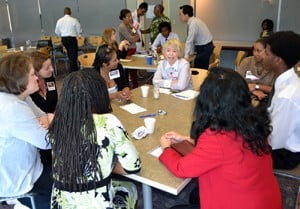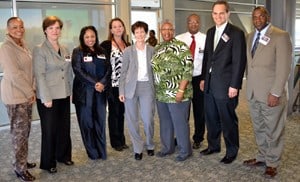Researchers Collaborate on Community Health Issues
May 17, 2011 | A recent gathering of about 40 researchers hosted by the UAMS Center for Clinical and Translational Research may prove a spark for new collaborations to address community health issues. The first meeting of the Community Engagement/Health Disparities Research Interest Group also drew two community programs hoping to team with UAMS researchers. The combination of researchers, local health providers, community groups and nonprofit organizations is a cornerstone of community engagement, said Robert Price, Ph.D., director of the CCTR’s community engagement core and a professor in the UAMS College of Medicine. “When those groups work together, it translates into program activities that take existing research and put into practice a mechanism that facilities generation of new research,” Price said at the May 4 meeting. Nancy Greer-Williams, Ph.D., coordinator of Community Based Research, said the interest group will meet every quarter to highlight community needs and provide information and workshops for researchers involved in community engagement or health disparities research. “We hope these meetings will spur collaborations in publication, grant writing and research,” she said. An example of an ongoing community engagement program is in Jefferson County where researchers led by Kate Stewart, M.D., M.P.H., community director for the community engagement component, are trying to identify why fewer minorities participate in clinical research and hoping to develop strategies for increasing that number. Ronda Henry-Tillman, M.D., and Glen Mays, Ph.D., highlighted the need for community engagement research. “Community engagement allows me to be a better doctor,” said Henry-Tillman, M.D., professor of surgery in the UAMS College of Medicine and director of the Cancer Control Program in the UAMS Winthrop P. Rockefeller Cancer Institute. She pointed to community-focused programs like the UAMS MammoVan, which is increasing the numbers of women getting mammograms in 26 Arkansas counties that lack FDA-approved certified mammography facilities. If a woman comes to her with advanced breast cancer, there may not be a lot she can do to help, she said. If a mammogram screening identifies an early-stage cancer, “I can do something about that.” Henry-Tillman said she believes its important to go into those communities and promote partnerships with community organizations or local health care providers. Mays, professor and chair of the UAMS College of Public Health Department of Health Policy and Management, said health services research and comparative effectiveness research is about answering three questions: (1) which health interventions work (2) for which populations and (3) under what circumstances. Mays said the first question requires traditional scientific approaches in efficacy and effectiveness research, “but far too often we in the research community stop there.” The second question requires a clear focus on health disparities and equity research. The third question requires community-centered and community-engaged research to understand the contexts in which health interventions are delivered and how these contexts — social, economic, environmental, institutional, and policy — interact to determine outcomes. “We need to answer all three questions to produce sustainable solutions to real-world health problems and reap the full benefits of our investments in health research,” he said. The event also drew two community programs hoping to team with UAMS researchers. Joni Lee, associate vice chancellor for University Advancement at the University of Arkansas at Little Rock, and state Sen. Joyce Elliott of Little Rock, spoke about the Promise Neighborhood Program. The area surrounding UALR was one of 21 to receive federal funding under the Promise Neighborhood program, Lee said. The program promotes a “cradle to career” concept where various programs and services focus on all children within the area to move them from birth through school and prepare them to lead successful lives. Researchers and health professionals can collaborate with these and other community groups to develop tools for data collection and information on health care and social services, Lee said. State Sen. David Johnson of Little Rock, vice president of community investment for the Arkansas Community Foundation, spoke about how that group seeks to connect funding with community projects. With 27 offices across the state, the foundation administrates funds from donors while grant-making to local communities and organizations. “I think there are a lot of public health initiatives that could benefit from the expertise of UAMS,” Johnson said. For more information about community engagement research or programs contact, communityengagement@uams.edu. |

